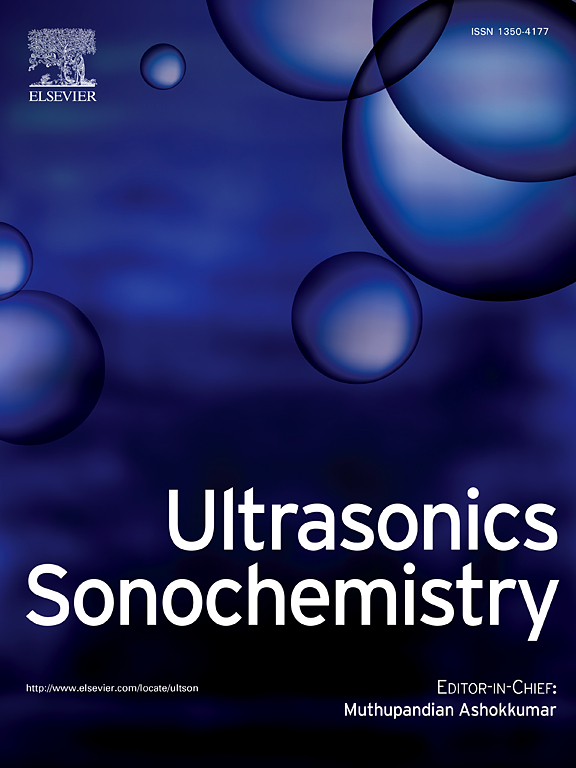浸泡过程中超声波对豇豆蒸煮过程中吸水及柔软特性的影响。
IF 8.7
1区 化学
Q1 ACOUSTICS
引用次数: 0
摘要
由于豆科植物蒸煮时间长,限制了豆科植物的消耗和利用,因此采用浸泡法来缩短蒸煮时间,节约能源消耗,降低豆科植物的硬度。然而,关于蒸煮和浸泡处理以及超声波处理对豆科植物水化、硬度和蒸煮时间缩短的影响研究有限。因此,本研究考察了蒸煮和浸泡处理对Dr. Saunder豇豆吸水率、硬度和蒸煮时间的影响。首先将Dr. Saunder's豇豆样品在30°C和50°C下浸泡15 - 90分钟(有和没有超声波),然后在100°C和121°C下煮15 - 120分钟。测量这些处理下测试样品的吸水性和硬度。根据获得的数据分别使用Ibarz-Augusto和一阶方程对水化和软化行为进行建模。采用阿伦尼乌斯方程描述了水化和软化过程的动力学。结果表明:超声处理加速了试样的吸水率,降低了试样的硬度;因此,在较短的时间内,使用较少的能量将获得所需的硬度作为最终产品。Ibartz-Augusto方程和一阶方程完美地拟合了吸附水和硬度数据的s型和衰减指数行为,预测性能高(R2≈1),误差值最小。研究发现,超声波的部署和蒸煮温度的升高可以降低其动力学参数(吸水率),提高软化速率和活化能(水化和软化)。三种处理的协同作用将总烹饪时间从120分钟减少到90分钟(25%),从而促进了利用超声波快速软化豇豆和其他种子的好处。本文章由计算机程序翻译,如有差异,请以英文原文为准。
Influence of ultrasonication during soaking on water absorption and Softness characteristics in the cooking process of cowpea
Owing to the long duration of cooking legumes, which limits their consumption and utilization, soaking has been used to reduce cooking time, save energy consumption, and diminish their hardness. However, limited studies have reported the influence of cooking and soaking treatment along with ultrasonication on hydration, hardness, and cooking time reduction of legumes. Therefore, this study investigated the impact of cooking and soaking treatments on Dr. Saunder cowpea’s water absorption, hardness, and cooking time reduction with and without ultrasonication. Samples of Dr. Saunder’s cowpea were first soaked at 30 °C and 50 °C for 15 – 90 min (with and without ultrasonication), after which they were cooked at 100 °C and 121 °C for 15 – 120 min. The absorbed water and hardness of the tested samples under these treatments were measured. Hydration and softening behaviors were modeled from the obtained data using Ibarz-Augusto and first-order equations, respectively. Arrhenius equation was used to describe the kinetics of the hydration and softening process. Results showed that ultrasonic treatments accelerated water absorption and reduced the hardness of the samples; consequently, in a shorter time, using less energy will receive the desired hardness as the final product. The Ibartz-Augusto and first-order equations perfectively fit the sigmoidal and decaying exponential behavior of the absorbed water and hardness data with high prediction performance (R2 ≈ 1) marked by minimal error values. The deployment of ultrasonication and increased cooking temperature were observed to reduce the kinetic parameter (water absorption) and elevate the softening rates and activation energy (for hydration and softening). A synergy of the trio treatments reduced the total cooking duration from 120 min to 90 min (25 %), thus promoting the benefit of deploying ultrasonication to soften cowpeas and other seeds rapidly.
求助全文
通过发布文献求助,成功后即可免费获取论文全文。
去求助
来源期刊

Ultrasonics Sonochemistry
化学-化学综合
CiteScore
15.80
自引率
11.90%
发文量
361
审稿时长
59 days
期刊介绍:
Ultrasonics Sonochemistry stands as a premier international journal dedicated to the publication of high-quality research articles primarily focusing on chemical reactions and reactors induced by ultrasonic waves, known as sonochemistry. Beyond chemical reactions, the journal also welcomes contributions related to cavitation-induced events and processing, including sonoluminescence, and the transformation of materials on chemical, physical, and biological levels.
Since its inception in 1994, Ultrasonics Sonochemistry has consistently maintained a top ranking in the "Acoustics" category, reflecting its esteemed reputation in the field. The journal publishes exceptional papers covering various areas of ultrasonics and sonochemistry. Its contributions are highly regarded by both academia and industry stakeholders, demonstrating its relevance and impact in advancing research and innovation.
 求助内容:
求助内容: 应助结果提醒方式:
应助结果提醒方式:


